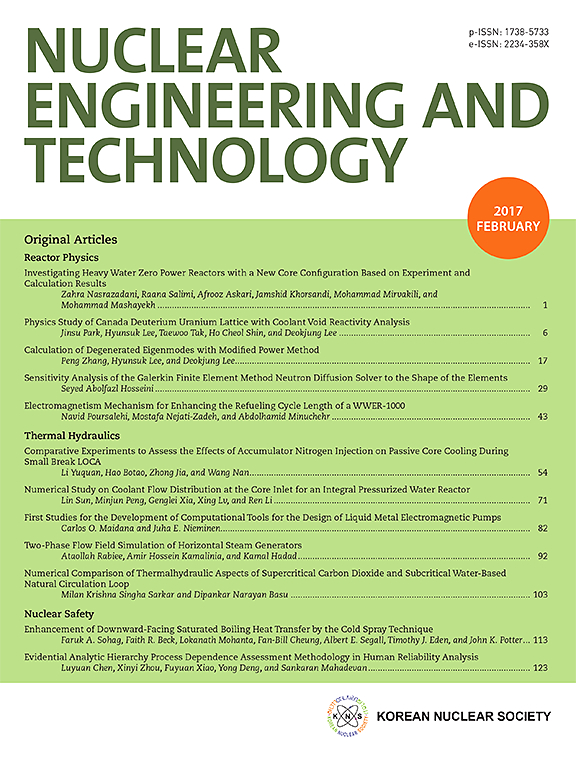现代建筑材料的放射性分析:印度泰米尔纳德邦玻璃化瓷砖中天然放射性核素的案例研究及其对健康的影响
IF 2.6
3区 工程技术
Q1 NUCLEAR SCIENCE & TECHNOLOGY
引用次数: 0
摘要
在印度泰米尔纳德邦广泛用作现代建筑材料的玻璃化瓷砖中,天然存在的放射性物质(NORM),特别是镭-226 (226Ra),钍-232(232Th)和钾-40 (40K)的活性浓度进行了调查。由于全球对建筑材料辐射暴露的关注日益增加,因此进行了全面的辐射评估,以评估与这些瓷砖有关的潜在健康危害。分析显示,226Ra的平均活性浓度为68±5 Bq kg - 1, 232Th的平均活性浓度为116±8 Bq kg - 1, 40K的平均活性浓度为540±40 Bq kg - 1。这些浓度明显高于UNSCEAR报告的相应的世界平均值:226Ra 50 Bq kg - 1, 232Th 50 Bq kg - 1, 40K 500 Bq kg - 1。因此,计算出的平均室内伽马吸收剂量率为124毫希·h−1,与这些瓷砖相关的估计超额终身癌症风险为2.13 × 10−3毫希·y−1,略高于联合国辐射科委会提出的全球平均值。虽然大多数指数的总体辐射危害仍在可接受的国际范围内,但这些观察到的特定参数的升高突出了继续保持警惕的重要性。为了进一步了解这些放射性核素的分布模式和相互关系,进行了多元统计分析,包括Pearson相关分析、层次聚类分析和主成分分析/因子分析。这些分析一致表明,226Ra和232Th是计算出的辐射危害指数的主要影响因素,它们与镭当量活度、吸收伽马剂量率和超额终身癌症风险等参数呈强正相关。相比之下,40K表现出不同的行为,对与这些瓷砖相关的潜在健康危害的贡献较小。研究结果强调需要对建筑材料进行特定区域的辐射评估,并建议在选择和使用瓷砖制造原材料方面可能需要监管指导,以确保公共辐射安全。本文章由计算机程序翻译,如有差异,请以英文原文为准。
Radiological profiling of modern building materials: A case study of natural radionuclides in vitrified tiles from Tamil Nadu, India and their health implications
The activity concentrations of naturally occurring radioactive materials (NORM), specifically radium-226 (226Ra), thorium-232(232Th), and potassium-40 (40K), in vitrified tiles widely used as modern building materials in Tamil Nadu, India, have been investigated. Since the global concern regarding radiation exposure from construction materials is increasing, a comprehensive radiological assessment was conducted to evaluate potential health hazards associated with these tiles. The analysis revealed mean activity concentrations of 68 ± 5 Bq kg−1 for 226Ra, 116 ± 8 Bq kg−1 for 232Th, and 540 ± 40 Bq kg−1 for 40K. These concentrations are notably higher than the corresponding world average values of 50 Bq kg−1 for 226Ra, 50 Bq kg−1 for 232Th, and 500 Bq kg−1 for 40K reported by UNSCEAR. Consequently, the calculated average indoor gamma absorbed dose rate of 124 nGy h−1 and the estimated excess lifetime cancer risk of 2.13 × 10−3 mSv y−1 associated with these tiles slightly exceed the global average values proposed by UNSCEAR. While the overall radiological hazard for most indices remains within acceptable international limits, these observed elevations in specific parameters highlight the importance of continued vigilance. To further understand the distribution patterns and interrelationships of these radionuclides, multivariate statistical analyses, including Pearson's correlation, hierarchical cluster analysis, and principal component analysis/factor analysis, were performed. These analyses consistently demonstrated that 226Ra and 232Th are the primary contributors to the calculated radiological hazard indices, as evidenced by their strong positive correlations with parameters such as radium equivalent activity, absorbed gamma dose rate, and excess lifetime cancer risk. In contrast, 40K exhibited a distinct behavior, contributing less significantly to the potential health hazards associated with these tiles. The research findings highlight the need for region-specific radiological assessments of building materials and suggest the potential need for regulatory guidance in selecting and using raw materials for tile manufacturing to ensure public radiation safety.
求助全文
通过发布文献求助,成功后即可免费获取论文全文。
去求助
来源期刊

Nuclear Engineering and Technology
工程技术-核科学技术
CiteScore
4.80
自引率
7.40%
发文量
431
审稿时长
3.5 months
期刊介绍:
Nuclear Engineering and Technology (NET), an international journal of the Korean Nuclear Society (KNS), publishes peer-reviewed papers on original research, ideas and developments in all areas of the field of nuclear science and technology. NET bimonthly publishes original articles, reviews, and technical notes. The journal is listed in the Science Citation Index Expanded (SCIE) of Thomson Reuters.
NET covers all fields for peaceful utilization of nuclear energy and radiation as follows:
1) Reactor Physics
2) Thermal Hydraulics
3) Nuclear Safety
4) Nuclear I&C
5) Nuclear Physics, Fusion, and Laser Technology
6) Nuclear Fuel Cycle and Radioactive Waste Management
7) Nuclear Fuel and Reactor Materials
8) Radiation Application
9) Radiation Protection
10) Nuclear Structural Analysis and Plant Management & Maintenance
11) Nuclear Policy, Economics, and Human Resource Development
 求助内容:
求助内容: 应助结果提醒方式:
应助结果提醒方式:


